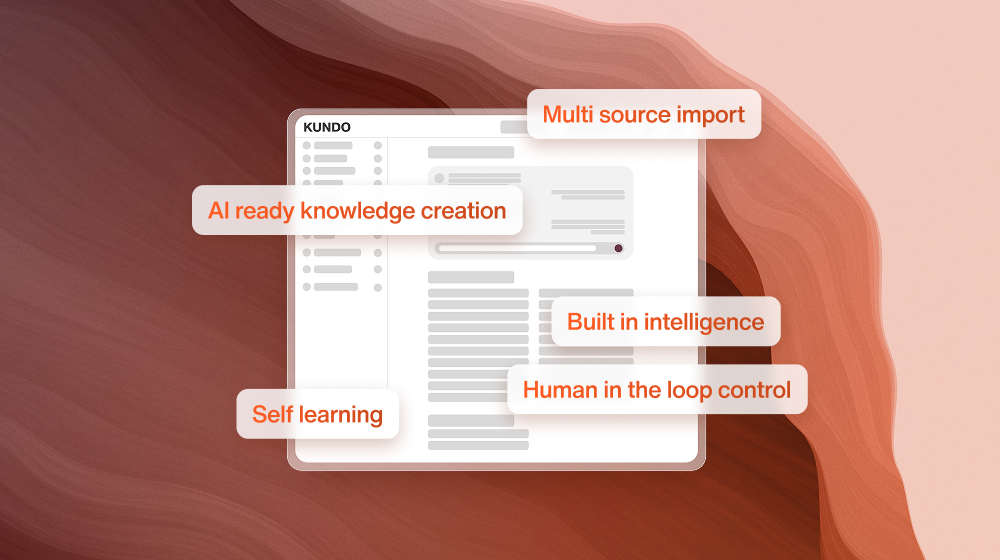
New ticketing features in Kundo
We're now launching several improvements in working with tickets in Kundo. Both around collaboration and in handling tickets. But let's start by zooming out a bit, and see how everything fits together.
Kundo has beeing in the ticketing business in over 10 years. We've gradually improved the platform, to make the experience seemless for people asking questions, for customer service agents, and to the manager that needs to follow up.
Customers often tell us in interviews that our way of working with tickets works exceptionally well, and that it's quite different from our competitor's ways. We believe that our principles around ticketing have helped immensely in settling down on this solution.
Customer service agents pick their own tickets
In some customer support systems tickets are "pushed" to specific agents. Rules are set up and "skills" are added to employees, in the name of productivity gain. Our experience is the opposite, that productivity goes down when you stop using the full employee skill set, and lean on fragile automation rules.
The system guesses the subject of the ticket, it guesses which tickets that fit a particular skillset, and it guesses if the timing is right for that kind of ticket. Why build IT-systems to automate a deeply human process, when there's a simpler option? Show the tickets to each agent, and let them pick the ticket that fits them best. It's not only more efficient, it's also what agents prefer if you ask them.
The customer service team shares responsibility for all tickets
Cooperation is the foundation of the best customer service teams. A quick question to a colleague. An e-mail to check something with the organization. Someone steps in when someone else is on vacation. They may seem like details, but they are essential for making the customer experience enjoyable.
This is why we've heavily invested in cooperation tools within Kundo, so that a tickets never get locked down, but can be open to anyone that wants to help. That's efficiency.
Features in Kundo for better ticketing
Here are a couple of examples of features in the platform, to show how the principles above lead to both a more efficient service and happier customers.
Kundo's dashboard
In the dashboard you find a a unified view of all tickets regardless of channel. They show up in a list, sorted by the person that has waited the longest for help. When a ticket is selected we mark that ticket as being worked in, without locking it. That leaves the choice to the agent: Pick another subject, or jump into the same ticket and work on it together.
The dashboard have been refined over many years, to deliver both a wide overview, and at the same time surface enough details. Filtering can bot be done ad-hoc and be saved for later, and features like mass-handling of tickets makes things efficient.
Ticketing tools
When looking at a specific ticket, all the tools you need to work efficiently is available. Mark that a ticket needs no answer, or that it needs follow-up. It can be assigned to a specific person, set as high prioritery, to categorized through a tagging system. Everything you expect from a modern ticketing system.
All actions are also logged to an event log per ticket, so that it's always possible to go back and see who did what, and when. Full control.
Tag colleagues in internal comments (new june-22)
One of the most loved features in the plattform is the possibility to discuss a ticket internally with colleagues. The discussion in parallel with the customer conversation, so it's always possible to refer back to what the customer wrote. Everything said in the internal conversation is of course searchable too, so it's easy to find it later.
To get the attention of a colleague, you just type "@Emil Stenström" in the comment, and a notification will be sent to the colleague. They click their way to the ticket, and can reply. A simple feature that has had a great reception when tricky processes get simplified.
Ask for help via mail (new june-22)
Tagging a colleague is great when the colleague already has a user account and works daily in Kundo. But you often need input from others when handing all the complex questions that lands in your inbox. Maybe you need someone from invoicing, or an external distributor that handles delivery.
Ask for help is almost like a separate little ticket system, where multiple external conversations can be handled in parallel, and where the original ticket show up as needing action when external parties answer. It's a very powerful what to work with complex tickets that require several people working together.
Group messages into tickets (planned autumn-22)
Work in progress. An e-mail is not always the same as a ticket. That's why work is ongoing to freely merge and split tickets. Connect messages across channels, and mark where one ticket ends and another one starts. This makes handling when people mix tickets in the same thread, or send several messages about the same case in different threads.
Ticketing status (planned autumn-22)
Work in progress. When tickets are about complex processes it can help to set a status on each ticket, and group tickets by status. It's then quick to get and overview with i.e. 5 tickets that waits for a reply from a distributor and 3 tickets that are unhandled. Today this can be built with tags and saved filters, but we think we can make this even more efficient. When tickets have statuses we can guarantee that all tickets have a status, let our ticketing tools automatically update the status, and more.
Interesting in more details?
All product development is done together with our customers. Curious in how we can make you ticketing more efficient? Or do you have suggestions on what a ticketing system should do to fit your needs?
Contact us and keep the discussion going!
(Already a customer? E-mail customer@kundo.se and we'll let you be the first to test our new features!)
We're now launching several improvements in working with tickets in Kundo. Both around collaboration and in handling tickets.

Emil Stenström
